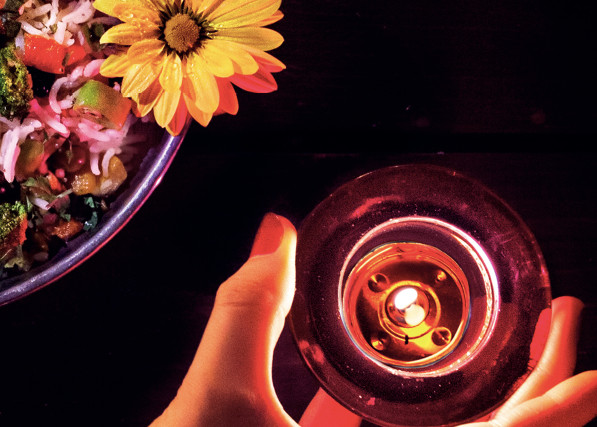We love Peter Novotny’s reflection on his experience of deep dating, a new phenomenon which is changing how we relate to each other for the better. Keep reading to learn more…
Intimacy
The Spark
Have a Positive Valentine Night with Joanne Faulkner of Shiatsu Conscious Cooking and her new book ‘Good Food: Better Sex’, a guide to intimacy and love using traditional Chinese medicine and food.
During this evening, Joanne will show you how to use the 5 elements of Traditional medicine to interpret your body’s symptoms and how to use the five flavours of food to treat emotional and physical conditions. She will discuss how the ancient art of using food as medicine can help you harness your powerful, creative sexual energy and direct it for better health and longevity. There will be tasty no sugar Millet Muffins to sample from the new book and together Joanne will talk about foods and demonstrate potent acupressure points to help with a range of conditions from low libido to night sweats and premature ejaculation.
More than just a cookbook, this is a journey with food providing the path back to love and acceptance for our sweet selves. We will discuss recipes that have sexual health benefits but more than that, we can learn how to empower and cherish ourselves with food.
Click here to learn more and book your tickets.
About Joanne:
Joanne Faulkner is a Shiatsu practitioner specialising in the energy of food in Traditional Chinese Medicine and runs a busy Shiatsu practice in Dublin, Ireland. Her Shiatsu & Conscious Cooking Demonstrations and Cookery Retreats regularly sell out. Currently, she serves as Chairperson of the Shiatsu Society of Ireland, ensuring the standards of Shiatsu practice in Ireland. Blogging regularly on her food and health-focused website www.joannefaulkner.ie, she is a published author of “Good Food: Better Sex” and “Shiatsu & the Art of Conscious Cooking”: both modern cookbooks full of delicious recipes, Traditional Chinese Medicine plus acupressure points for health and wellbeing.
Tantric visionary and educator Dawn Cartwright shares her beautiful insights about kindness in the bedroom, and the difference this can make to our intimate lives. This article appeared in our Spring 2019 issue.
We wanted to share this enlightening article by Dawn Cartwright, which appears in our Spring 2018 issue. Here, she discusses how the traditional and contemporary forms of Tantra can be harmoniously blended together to work towards healing and empowerment. She says, “Neo-Tantra weaves threads between the the sexual and the spiritual, the human and the divine, demonstrating, in very beautiful ways, that each exists in the other.” Read on to learn more! Dawn’s website is dawncartwright.com.

What is Neo-Tantra? Complementary Aspects of the Old & New
by Dawn Cartwright
“The Munis, girdled with the wind, wear garments soiled of yellow hue.
They, following the wind’s swift course, go where the Gods have gone before.”
~Excerpt from Ke?in Hymn, 10.136 of the Rigveda, as translated by Ralph T. H. Griffith
Some of the earliest written evidence of Tantra appears in the RigVeda, the oldest of the Vedic Texts, dated roughly between 1100 and 500 B.C.E. The Ke?in Hymn, 10.136 of the Rigveda, describes dust-clad munis who cavorted with the wind. The muni, know for their pursuit of ecstasy, engaged in practices far outside the Brahmanical norm; defining evidence of an early Tantra tradition.
Defining Tantra
Tantra is a vast and controversial subject – to define it is a challenging task. Many elements of Tantra are also found in other Hindu and Vedic paths. Yet when we take the view that ecstasy creates the cosmos, Tantra is a path rich with possibility.
The origins of Tantra date back to the Upper Paleolithic Period, nearly 28,000 years ago. It is rooted in reverence for the microcosm-macrocosm view of fertility and the birth of the universe. The earliest traditions, much like the muni, were closely connected to nature. The Tantra sutras, revealing the secrets of existence, were songs sung by the wind, trees, rivers, oceans and mountains. These songs were translated by great mystics into Mantras, Yantras and Tantras.
The tradition we are most familiar with today is Neo-Tantra, the “new” or “revived” version of Tantra. Neo-Tantra is known for its embrace of sexuality: a perceptive that has drawn a great deal of controversy and skepticism. The Christian repressive attitudes prevalent even in India have enforced a separation between the spiritual and physical. Neo-Tantra weaves threads between the the sexual and the spiritual, the human and the divine, demonstrating, in very beautiful ways, that each exists in the other.
Scholars, Mystics & Lovers
“The Tantras most often tend to prefer more esoteric subjects: speculations on the nature of the Absolute, cosmogony, the creative nature of sound and word, micro-macrocosmic equivalence, the powers of speech, communication and handling of mantras, symbolic interpretations of words and names, construction of and initiation into mandalas and worship of deities therein.”
~Teun Goudriaan, History of Indian Literature Volume II
To explore Tantra is to experience a mystery that constantly unfolds without end. To understand Neo-Tantra and the ways this new tradition is complimentary to the classical traditions, it’s helpful to understand three perspectives: the scholarly, the classical and the new.
The Scholar To the Tantra scholar, the Tantras are commentaries on the original Tantra sutras, and are often found to be more in-depth and more coherent than the original sutras themselves. The Tantras reveal an esoteric world known only to Tantra adepts.
The Mystic To the practitioner of the classical form, Tantra is one aspect of Mantra, Yantra, Tantra. Mantra is sacred sound. Yantra is sacred geometry. Tantra refers to the methods used to merge the practitioner with Mantra and Yantra. Initiation through a guru is a key element of the classical path. It is said the power contained in Mantra, Yantra and Tantra comes to life when received through guru initiation.
The Lover To the Neo-Tantra practitioner, Tantra is the weaving together of sexuality and spirituality. The quest is to experience the beloved as divine. Neo-Tantra includes classical Tantra themes and practices, woven together with modern-day sexology, humanistic psychology and bio-energetics.
Complimentary Elements & Gifts
Often believed to be in conflict with one another, Tantra in its classical form and Neo-Tantra are in fact complimentary. The classical form of Tantra brings gifts of focus, dedication and devotion to the Neo-Tantra practice, while Neo-Tantra brings confidence, energy awareness and self-revelation to the classical practice.
CLASSICAL TANTRA ELEMENT: THE GIFT
Yantra Focus Awakens new neural pathways, making it possible for sexuality to reach new levels of pleasure and connection.
Mantra: Dedication Teaches the modern-day lover the value of sustained attention and the benefits of commitment.
Tantra/Puja: Devotion Reveals the transcendent quality of giving and receiving. Seeing the divine in everything. Merging with the divine in the beloved.
NEO-TANTRA ELEMENT: THE GIFT
Sexuality: Confidence Increases tapas, the fire of transformation, grounding the classical practices in the human body.
Bio-energetics: Energy Awareness Releases physical tension in the body, unlocking the free flow of Kundalini energy.
Humanistic Psychology: Self-revelation Bridges the inner experience with the outer reality. Tools for self-honesty, maturity and responsibility.
The wisdom of Tantra in its classical form offers important structure and guidance to the Neo-Tantra practitioner. Neo-Tantra practices bring new vitality to a mystical path rich with tradition. The two go hand in hand, following the wind’s swift course toward ecstasy.
Dawn Cartwright is a Tantric visionary, sacred writer, world traveler, and innovator in bio-energetic Tantra fusion. To learn more about her work, go to: www.dawncartwright.com.
Sneak Peek: What is Neo-Tantra? Complementary Aspects of Old & New
Tonight, we wanted to share a sneak peek of this beautiful article written by our Tantra expert Dawn Cartwright. You can read the entire article in our new Spring issue, available in your local stockist or through subscription. Don’t forget to check out the details of Dawn’s special Positive Nights event with us on Wednesday the 25th of April too!

By Dawn Cartwright
“The Munis, girdled with the wind, wear garments soiled of yellow hue.
They, following the wind’s swift course, go where the Gods have gone before.”
Excerpt from Ke?in Hymn, 10.136 of the Rigveda, as translated by Ralph T. H. Griffith
Some of the earliest written evidence of Tantra appears in the RigVeda, the oldest of the Vedic Texts, dated roughly between 1100 and 500 B.C.E. The Ke?in Hymn, 10.136 of the Rigveda, describes dust-clad munis who cavorted with the wind. The muni, know for their pursuit of ecstasy, engaged in practices far outside the Brahmanical norm; defining evidence of an early Tantra tradition.
Defining Tantra
Tantra is a vast and controversial subject – to define it is a challenging task. Many elements of Tantra are also found in other Hindu and Vedic paths. Yet when we take the view that ecstasy creates the cosmos, Tantra is a path rich with possibility.
The origins of Tantra date back to the Upper Paleolithic Period, nearly 28,000 years ago. It is rooted in reverence for the microcosm-macrocosm view of fertility and the birth of the universe. The earliest traditions, much like the muni, were closely connected to nature. The Tantra sutras, revealing the secrets of existence, were songs sung by the wind, trees, rivers, oceans and mountains. These songs were translated by great mystics into Mantras, Yantras and Tantras.
The tradition we are most familiar with today is Neo-Tantra, the “new” or “revived” version of Tantra. Neo-Tantra is known for its embrace of sexuality: a perceptive that has drawn a great deal of controversy and skepticism. The Christian repressive attitudes prevalent even in India have enforced a separation between the spiritual and physical. Neo-Tantra weaves threads between the the sexual and the spiritual, the human and the divine, demonstrating, in very beautiful ways, that each exists in the other.
Scholars, Mystics & Lovers
“The Tantras most often tend to prefer more esoteric subjects: speculations on the nature of the Absolute, cosmogony, the creative nature of sound and word, micro-macrocosmic equivalence, the powers of speech, communication and handling of mantras, symbolic interpretations of words and names, construction of and initiation into mandalas and worship of deities therein.”
~Teun Goudriaan, History of Indian Literature Volume II
To explore Tantra is to experience a mystery that constantly unfolds without end. To understand Neo-Tantra and the ways this new tradition is complimentary to the classical traditions, it’s helpful to understand three perspectives: the scholarly, the classical and the new.
________________________
You can read the full article by picking up a copy of our Spring issue or subscribing today. Dawn will be a special guest at Positive Nights on Wednesday the 25th of April, from 7.30 to 9.30p.m. at Powerscourt Theatre, Dublin 2. The theme of her event is “Bringing Dating Back.” She will talk about how the sacred energy of ancient Tantric rituals called the Pancha Upacaras can be used to inspire greater devotion and intimacy in our modern-day dating lives. You can learn more about the event on our website, Facebook or Meetup, and book your tickets at this Eventbrite link.






